Quantitative Modelling and Perspective Taking: Two Competencies of Decision Making for Sustainable Development
Abstract
1. Introduction
Which competencies do learners bring to the quantitative evaluation and reflection of potential real-world decision-making options on Sustainable Development issues?
1.1. Sustainable Development Issues as Socioscientific Issues
- Sustainable Development issues are factually complex. This results in factual uncertainty in assessment and judgment [16]. When establishing a Marine Protected Area, the data are often incomplete. That is because of uncertainty regarding fish stock sizes, ecosystem interactions of different populations or changing biotic as well as abiotic factors. Therefore, and also as for SSIs, scientific evidence may be fragile, requiring ongoing inquiry [8,19,20].
- Sustainable Development issues are at the interface of science and multiple societal considerations [21]. Designating a Marine Protected Area implies a broader range of societal concerns by communicating effects from the individual level (e.g., individual opportunity costs of local fisherman due to fishing restrictions) up to a global level, i.e., welfare gain in terms of food production and climate regulation. To analyze causes and effects of current ecosystem exploitation patterns, and to devise potential options require knowledge from the natural sciences (marine biology), engineering/applied sciences (fishing and aquaculture technology) and the social and economic sciences (resource economics [11], institutional economics, rural sociology).
- Sustainable Development issues are normatively controversial. Any specific Marine Protected Area is likely to differentially affect concerned coastal stakeholders: Traditional fishing folk at tropical shores may favor a ban on mangrove conversion to shrimp farms but may oppose restrictions on coastal fisheries. In contrast, stakeholders involved in shrimp aquaculture are likely to oppose a ban on mangrove conversion and be indifferent concerning fishing restrictions. Other examples include conflicts between tourism, biodiversity conservation and the fishing industry. This setting results in multidimensional socioeconomic, cultural and political conflicts. Solutions that please all stakeholders are difficult. Thus, implementing a Marine Protected Area is often normatively controversial [18].
- Sustainable Development issues are goal- and decision-oriented. The designation of a Marine Protected Area implies several decisions about the location, the size and restrictions (cf. Appendix A.1 and Appendix A.2).
1.2. Socioscientific Reasoning and Decision Making for Sustainable Development
1.3. Research Questions
- RQ 1.1
- In which way can ERSQE adequately be modelled and measured?
- RQ 1.2
- Which is/are the resulting dimension(s)?
- RQ 1.3
- In which way can we use the items of the resulting dimension(s) for different levels of education?
- RQ 2.1
- In which way does/do competence/ies according to the resulting dimension(s) increase with the level of education?
- RQ 2.2
- In which way does/do the resulting dimension(s) differ from qualitative arguing?
- RQ 2.3
- In which way does/do the resulting dimension(s) differ from related constructs such as economic literacy, mathematical competencies, reading competencies and analytical problem solving?
2. Method and Approach
2.1. Measurement Instrument: Composition and Administration
2.2. The Scoring of Empirical Data
2.3. Sample
2.4. Procedure in Competence Modelling
2.5. Correlation and Group Comparisons in Validation Studies
3. Results
3.1. First Set of Research Questions—Dimensionality, Measurement, and Differential Item Functioning
3.1.1. Modelling and Dimensionality
3.1.2. Quantitative Modelling and Perspective Taking: Test Quality and Wright Map
3.1.3. Differential Item Functioning
3.2. Second Set of Research Questions—Validation
3.2.1. Competence Increase in Quantitative Modelling and Perspective Taking with Level of Education
3.2.2. Quantitative Modelling and Perspective Taking with Qualitative Arguing
3.2.3. Quantitative Modelling and Perspective Taking and Further Related Constructs
4. Discussion
4.1. First Set of Research Questions—Dimensionality, Measurement, and Differential Item Functioning
4.1.1. Dimensionality
4.1.2. Quantitative Modelling
4.1.3. Perspective Taking
4.1.4. Differential Item Functioning
4.2. Second Set of Research Questions—Validation Studies
4.2.1. Competence Increase in Quantitative Modelling and Perspective Taking with Level of Education
4.2.2. Quantitative Modelling and Perspective Taking: Two distinct Dimensions to Qualitative Arguing
4.2.3. Quantitative Modelling, Perspective Taking and further Related Constructs
4.3. Limitations
5. Conclusions
Author Contributions
Funding
Acknowledgments
Conflicts of Interest
Appendix A
Appendix A.1. Information Booklet for the Resource Use Issue—Marine Resource Use Task—Part I
| Features | Marine Protected Area 1 | Marine Protected Area 2 | Marine Protected Area 3 |
|---|---|---|---|
| Area [ha] | 125,700 | 156,000 | 147,300 |
| Percentage of Endangered Species and Habitats [%] | 20 | 60 | 60 |
| Special Features of the Marine Protected Area | None | Fish breeding grounds and fish nursery | Does not include coastal regions |
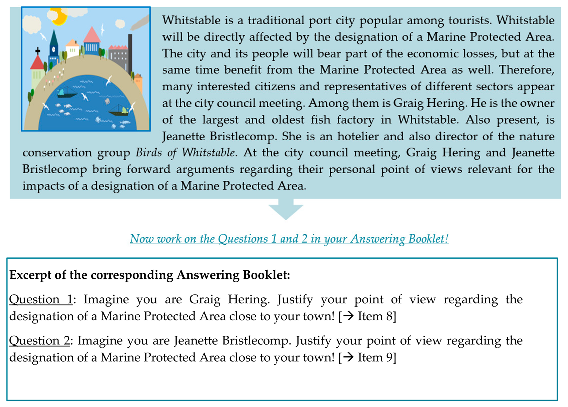
Appendix A.2. Information Booklet for the Resource Use Issue—Marine Resource Use Task—Part II
| Economic Sectors | Marine Protected Area 1 | Marine Protected Area 2 | Marine Protected Area 3 |
|---|---|---|---|
| Fisheries [€] | 208 million | 227 million | 346 million |
| Oil and Gas Companies [€] | 535 million | 811 million | 799 million |
| Telecommunications and Energy Companies [€] | 24 million | 57 million | 43 million |
| Ecosystem Services | Marine Protected Area 1 | Marine Protected Area 2 | Marine Protected Area 3 |
|---|---|---|---|
| Food Production and Climate Regulation [€] | 8000 million | 18,000 million | 14,000 million |
| Tourism, Research, Leisure and Recreation [€] | 2000 million | 2500 million | 2800 million |
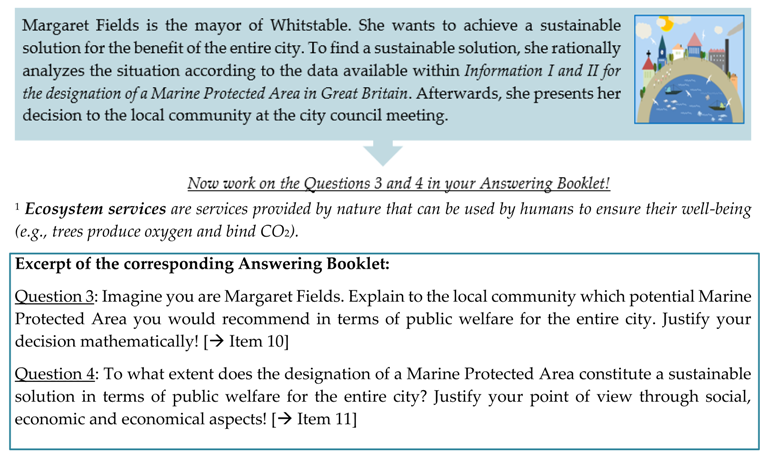
Appendix B
Appendix B.1. Overview of all Items for Quantitative Modelling:
- ●
- Content,
- ⮚
- Economics Concept(s),
- -
- Sustainable Development issues [Environmental Policy Instrument], and
- σ
- Item-Difficulty
| Items regarding Quantitative Modelling | σ | |
| 1 |
| −0.17 |
| 15 |
| −0.11 |
| 5 |
| 0.07 |
| 2 |
| 0.46 |
| 13 |
| 0.60 |
| 10 |
| 0.60 |
| 12 |
| 0.67 |
| 16 |
| 0.68 |
Appendix B.2. Overview of all Items for Perspective Taking:
- ●
- Content,
- ▲
- Sustainable Development-relevant Norms or Perspectives respectively,
- -
- Sustainable Development issues [Environmental Policy Instrument], and
- σ
- Item-Difficulty
| Items regarding Perspective Taking | σ | |
| 8 |
| −1.00 |
| 9 |
| −0.74 |
| 6 |
| −0.06 |
| 7 |
| 0.10 |
| 3 |
| 0.11 |
| 11 |
| 0.22 |
| 14 |
| 0.71 |
| 4 |
| 1.33 |
Appendix C
Appendix C.1. Scoring of Item 10—Quantitative Modelling
| Item 10 Marine Resource Use Issue | |||||
| Question: | Imagine you are Margaret Fields [major of the town Whitstable]. Explain to the local community which potential Marine Protected Area you would recommend in terms of public welfare for the entire city. Justify your decision mathematically! | ||||
| Content: | Multi-Step Mathematical Modelling, Manageable Data | ||||
| Economics Concepts: | Public Welfare and Cost/Benefit | ||||
| Scoring | Responses | ||||
| 0 |
| 9th grade, female, 16 years old I would recommend Marine Protected Area 1 because it includes the smallest percentage of endangered species and there are not many restrictions for the fishery. In addition, the costs for individual economic sectors are lowest for Marine Protected Area 1. Also in regard of the use for the general public for the next 20 years the costs are rather small. | |||
| 1 |
| 9th grade, sex not specified, 15 years old Marine Protected Area 2 should be designated. - € 227 million € 18,000 million - € 811 million € 2500 million - € 57 million - € 1095 million € 20,500 million € 20,500 million - € 1095 million = € 19,405 million A benefit of € 19,405 million. | |||
| 2 |
| 11th grade, male, 17 years old Benefits Marine Protected Area 1 € 9233 million Marine Protected Area 2 € 19,405 million Marine Protected Area 3 € 15,612 million → Marine Protected Area 2 generates the highest benefit while safeguarding the protected species in 60% of the area. | |||
| 3 |
| 11th grade, male, 17 years old | |||
| Marine Protected Area | 1 | 2 | 3 | ||
| Area/Surface | 125,700 ha | 156,000 ha | 147,300 ha | ||
| Costs [€] | −767 million | −1095 million | −1188 million | ||
| Benefits [€] | +10,000 million | + 20,500 million | + 16,800 million | ||
| Total [€] | +9233 million | + 19,405 million | + 15,612 million | ||
| Per Hectare [€] | +0.0734 million | + 0.1244 million | + 0.1059 million | ||
| In regard of the city’s benefit, I would recommend Marine Protected Area 2, since it contains 60% endangered species which need to be protected on one hand, and contains fish spawning grounds and nurseries, and on the other hand, the city would benefit in the next 20 years from the benefit of up to € 19,405 million. At the same time, Marine Protected Area 2 is by far the biggest profit per hectare in the next 20 years, even though it occupies a large area of 156,000 ha, it comes with a great benefit. | |||||
Appendix C.2. Scoring of Item 11—Perspective Taking
| Item 11 Marine Resource Use Issue | ||
| Question: | To what extent does the designation of a Marine Protected Area constitute a sustainable solution in terms of public welfare for the entire city? Justify your point of view through social, economic and economical aspects! | |
| Content: | Reasoning of the Environmental Policy Instrument Marine Protected Area | |
| Remark: | Taking three Sustainable Development-specific Perspectives: Ecological, Economic and Social | |
| Scoring | Responses | |
| 0 |
| 9th grade, female, 15 years old It’s a great way to protect fish species that are threatened with extinction. Even the natural space is preserved in a natural way. |
| 1 |
| 9th grade, male, 15 years old Social: research for the general public Ecological: natural space for fish is preserved, regeneration of fish stocks and water quality Economic: |
| 2 |
| 11th grade, female, 17 years old From an ecological point of view, the non-use promotes ecosystem services and thus also food production. From a social point of view, the expansion of nature reserves promotes the recreational factor of tourists. Even economically (see Table A3), the implementation of a Marine Protected Area has only advantages, as you can see the expenses cover the revenues and you get high profits. |
| 3 |
| 10th grade, female, 16 years old I think that a Marine Protected Area is a good solution. Everyone has advantages and disadvantages. Socially: There is more food, tourism, research, leisure and recreation. Ecologically: It would protect the environment and also their living beings more and in a sustainable manner. Economically: The fishery would suffer as they have less revenue in the first few years until the fish stocks have recovered. Employees have to be dismissed and there would be financial losses. Nevertheless, in the end, every aspect, socially, ecologically and economically, has something of it. I think it’s a good solution, because at some point we have to start with sustainable thinking. Our children also want to eat fish. |
Appendix D
Appendix D.1. Scoring Rubric for the Items of Quantitative Modelling
| Item 1 | Item 5 | Item 2 | Item 10 | Item 13 | Item 15 | Item 16 | Item 12 | |
| Sustainable Development issue | Land Use Change | Marine Resource Use | Climate Change | |||||
| Content | One-Step Mathematical Modelling, very Manageable Data | Multi-Step Mathematical Modelling, Manageable Data, Additional Constraint (secured livelihood) | Multi-Step Mathematical Modelling, Manageable Data | Reasoned Decision Making regarding the Environmental Policy Instrument European Union Emission Trading System | Reflection of given Multi-Step Mathematical Modelling with Manageable Data; Determination of an Error in one Modelling Step | |||
| Immanent Economics Concept(s) | Profit Maximization | Financial Incentives | Minimum Principle | Public Welfare Cost and Benefit | Cost-Efficiency Market Failure | Supply/Demand Financial Incentives | Supply/Demand (Pricing) Externalities | (without any Economics Concept to consider) |
| Score 0 | Concept(s) not or correctly applied (implicitly); Mathematical Modelling incorrect or false, incompletely documented | Both Concepts missing or incorrect | Valid Reasoning of Mathematical Modelling might be given but Error within Mathematical Modelling not mentioned | |||||
| Score 1 | Concept(s) at least correctly applied (implicitly); Mathematical Modelling with correct Result, incompletely documented | One Concept correctly applied (implicitly) | [See Score 0] Plus: a viable and sophisticated Criticism regarding European Union Emission Trading System | One Concept correctly applied (implicitly) | Error mentioned but not precisely determined and valid Reasoning of Mathematical Modelling given or: Error precisely determined but valid Reasoning of Mathematical Modelling missing | |||
| Approximate Calculation | Quantification partly applied | |||||||
| Score 2 | [See Score 1] Plus: Mathematical Results transferred back to Sustainable Development issue | Both Concepts correctly applied (implicitly) | [See Score 1] Plus: One Concept correctly applied (implicitly) | Both Concepts correctly applied (implicitly) | Error precisely determined and valid Reasoning of the Mathematical Modelling given | |||
| Mathematical Modelling completely documented | Quantification completely applied | |||||||
| Score 3 | [See Score 2] Plus: Mathematical Modelling correctly and completely documented | No Score 3 available | No Score 3 available | [See Score 2] Plus: Concepts correctly applied (at least implicitly); Mathematical Modelling correctly and completely documented | No Score 3 available | [See Score 2] Plus: Both Concepts correctly applied (implicitly) | No Score 3 available | No Score 3 available |
Appendix D.2. Scoring Rubric for the Items of Perspective Taking
| Item 3 | Item 11 | Item 14 | Item 4 | Item 6 | Item 7 | Item 8 | Item 9 | |
| Sustainable Development issue | Land Use Change | Marine Resource Use | Climate Change | Land Use Change | Marine Resource Use | |||
| Content | Reflecting the Consequences of Conflicting Interests in Stakeholder Land Use Decisions | Reasoning of the Environmental Policy Instrument Marine Protected Area | Reasoning of the Environmental Policy Instrument European Union Emission Trading System | Reflecting the Consequences of Conflicting Interests in Stakeholder Land Use Decisions | Positioning with respect to the Environmental Policy Instrument Reducing Emissions from Deforestation and Forest Degradation | Arguing for or against the Environmental Policy Instrument Reducing Emissions from Deforestation and Forest Degradation | Positioning with respect to the Environmental Policy Instrument Marine Protected Area | |
| Perspective taking | Taking three Sustainable Development-specific Perspectives: Ecological, Economic and Social | Taking the Sustainable Development-relevant Perspective: Global Impact | Taking the Sustainable Development-specific Perspectives: Basic Needs, Inter- and Intragenerational Justice | Taking three Sustainable Development-specific Perspectives: From Local to Global Levels | Taking a Sustainable Development-specific Stakeholder Perspective | |||
| Remark | Perspective taking on a concrete Stakeholder-Level (Family) | Perspective taking on a general Level regarding the Benefits and/or Costs for the Humanity | Perspective taking on a general Level regarding the Sustainable Development-relevant Principles and Objectives | Taking of different Perspectives: Family/Community, Society and Humanity | Perspective taking of a Stakeholder: Economic interests | Perspective taking of a Stakeholder with Conflicting Interests: Economic vs. Ecological | ||
| Score 0 | Perspective taking missing, superficial or Perspective taking given and Point of View substantiated by … | |||||||
| … one valid Argument for one Perspective | … one valid Argument (implicitly) | … one valid Argument | … one valid Argument for one Perspective | … one valid Argument for the specific Stakeholder Perspective | ||||
| Score 1 | Perspective taking given and Point of View substantiated by … | |||||||
| … one valid Argument for each of two Perspectives | … two valid Arguments (at least implicitly) | … two valid Arguments | … one valid Argument for each of two Perspectives | … two valid Arguments for the specific Stakeholder Perspective | ||||
| Score 2 | Perspective taking given and Point of View substantiated by … | |||||||
| … one valid Argument for each of three Perspectives | … at least two valid Arguments (at least implicitly) | [See Score 1] Plus: a viable and sophisticated Criticism regarding Reducing Emissions from Deforestation and Forest Degradation | … one valid Argument for each of three Perspectives | … at least three valid Arguments for the specific Stakeholder Perspective | ||||
| Score 3 | [See Score 2] Plus: more than one valid Argument for at least two Perspectives | No Score 3 available | No Score 3 available | [See Score 2] Plus: each Perspective specified | No Score 3 available | No Score 3 available | ||
References
- UNESCO. Education for Sustainable Development: Towards achieving the SDGs (ESD for 2030). Available online: https://www.bne-portal.de/sites/default/files/draft_framework_esd_annex_eng.pdf (accessed on 12 August 2019).
- TEEB. The Economics of Ecosystems and Biodiversity: Mainstreaming the Economics of Nature: A Synthesis of the Approach, Conclusions and Recommendations of TEEB. Available online: http://www.teebweb.org/our-publications/teeb-study-reports/synthesis-report/ (accessed on 12 August 2020).
- Cinici, A. Balancing the pros and cons of GMOs: Socio-scientific argumentation in pre-service teacher education. Int. J. Sci. Educ. 2016, 38, 1841–1866. [Google Scholar] [CrossRef]
- Eggert, S.; Bögeholz, S. Students’ Use of Decision-Making Strategies with Regard to Socioscientific Issues—An Application of the Rasch Partial Credit Model. Sci. Educ. 2010, 94, 230–258. [Google Scholar] [CrossRef]
- Böhm, M.; Eggert, S.; Barkmann, J.; Bögeholz, S. Evaluating sustainable development solutions quantitatively: Competence modelling for GCE and ESD. CSEE 2016, 15, 190–211. [Google Scholar] [CrossRef]
- Seeber, G.; Birke, F. Using a Fox to Guard the Geese? A German Debate on the Purposes of Economic Education in Relation to Sustainability and the Role of Values. CSEE 2011, 10, 170–181. [Google Scholar] [CrossRef]
- Romine, W.L.; Sadler, T.D.; Kinslow, A.T. Assessment of scientific literacy: Development and validation of the quantitative assessment of socio-scientific reasoning (QuASSR). J. Res. Sci. Teach. 2017, 54, 274–295. [Google Scholar] [CrossRef]
- Sadler, T.D.; Barab, S.A.; Scott, B. What do students gain by engaging in socioscientific inquiry? Res. Sci. Educ. 2007, 37, 371–391. [Google Scholar] [CrossRef]
- Crowley, R.M.; Swan, K. What Kind of Economic Citizen? An Analysis of Civic Outcomes in U.S. Economics Curriculum and Instruction Materials. Educ. Sci. 2018, 8, 95. [Google Scholar] [CrossRef]
- De Beckker, K. Financial Literacy. Uncovering avenues for future research. In Financial Education—Current Practices and Future Challenges; De Witte, K., Holz, O., De Beckker, K., Eds.; Waxmann: Münster, Germany; New York, NY, USA, 2020; pp. 11–40. [Google Scholar]
- Löw Beer, D. Teacher Trainees Conceptions of Economic Policy Instruments for the Environment. JEEER 2018, 19, 1–21. [Google Scholar]
- Harring, N.; Davies, P.; Lundholm, C. Learning Economics and Attitudes to Market Solutions to Environmental Problems. Educ. Sci. 2017, 7, 36. [Google Scholar] [CrossRef]
- Sternäng, L.; Lundholm, C. Climate change and costs: Investigating students’ reasoning on nature and economic development. Environ. Educ. Res. 2012, 18, 417–436. [Google Scholar] [CrossRef]
- Bögeholz, S.; Barkmann, J. Rational choice and beyond: Handlungsorientierende Kompetenzen für den Umgang mit faktischer und ethischer Komplexität. [Action-oriented competencies for dealing with factual and ethical complexity] In Lehr-und Lernforschung in der Biologiedidaktik. Band 2; Klee, R., Sandmann, A., Vogt, H., Eds.; Studienverlag: Innsbruck, Austria, 2005; pp. 211–224. [Google Scholar]
- Bögeholz, S.; Barkmann, J. “…to help make decisions”: A challenge to science education research in the 21st century. In Science Education Research and Education for Sustainable Development, Proceeding of the 22nd Symposium on Chemistry and Science Education, Bremen, Germany, 19–21 June 2014; Eilks, I., Markic, S., Ralle, B., Eds.; Shaker Verlag: Aachen, Germany, 2014; pp. 25–35. [Google Scholar]
- Bögeholz, S.; Böhm, M.; Eggert, S.; Barkmann, J. Education for Sustainable Development in German Science Education: Past-Present-Future. Eurasia J. Math. Sci. Technol. Ed. 2014, 10, 231–248. [Google Scholar] [CrossRef]
- Sadler, T.D. (Ed.) Socio-Scientific Issues in the Classroom: Teaching, Learning and Research; Springer: Dordrecht, The Netherlands, 2011. [Google Scholar]
- Bennett, N.J.; Dearden, P. Why local people do not support conservation: Community perceptions of marine protected area livelihood impacts, governance and management in Thailand. Mar. Policy 2014, 44, 107–116. [Google Scholar] [CrossRef]
- Kolstø, S.D. Patterns in students’ argumentation confronted with a risk-focused socioscientific issue. Int. J. Sci. Educ. 2006, 28, 1689–1716. [Google Scholar] [CrossRef]
- Eggert, S.; Nitsch, A.; Boone, W.J.; Nückles, M.; Bögeholz, S. Supporting Students’ Learning and Socioscientific Reasoning About Climate Change. The Effect of Computer-Based Concept Mapping Scaffolds. Res. Sci. Educ. 2016, 47, 137–159. [Google Scholar] [CrossRef]
- Oulton, C.; Dillon, J.; Grace, M.M. Reconceptualizing the teaching of controversial issues. Int. J. Sci. Educ. 2004, 26, 411–423. [Google Scholar] [CrossRef]
- Zeidler, D.L. Socioscientific issues as a curriculum emphasis: Theory, research and practice. In Handbook of Research on Science Education, 1st ed.; Abell, S.K., Lederman, N.G., Eds.; Routledge: New York, NY, USA, 2014; pp. 697–726. [Google Scholar]
- Stanger-Hall, K.F. Multiple-choice exams: An obstacle for higher-level thinking in introductory science classes. CBE Life Sci. Educ. 2012, 11, 294–306. [Google Scholar] [CrossRef]
- Martinez, M.E. Cognition and the question of test item format. Educ. Psychol. 1999, 34, 207–218. [Google Scholar] [CrossRef]
- Dufresne, R.J.; Leonard, W.J.; Gerace, W.J. Making sense of students’ answers to multiple-choice questions. Phys. Teach. 2002, 40, 174–180. [Google Scholar] [CrossRef]
- Sakschewski, M.; Eggert, S.; Schneider, S.; Bögeholz, S. Students’ socioscientific reasoning and decision-making on energy-related issues—Development of a measurement instrument. Int. J. Sci. Educ. 2014, 36, 2291–2313. [Google Scholar] [CrossRef]
- Masters, G. A Rasch model for partial credit scoring. Psychometrika 1982, 47, 149–174. [Google Scholar] [CrossRef]
- Boone, W.J.; Scantlebury, K. The role of Rasch analysis when conducting science education research utilizing multiple choice tests. Sci. Educ. 2006, 90, 253–269. [Google Scholar] [CrossRef]
- Cronbach, L.J.; Meehl, P.E. Construct validity in psychological tests. Psychol. Bull. 1955, 52, 281–302. [Google Scholar] [CrossRef] [PubMed]
- Martinková, P.; Drabinová, A.; Liaw, Y.L.; Sanders, E.A.; McFarland, J.L.; Price, R.M. Checking equity: Why differential item functioning analysis should be a routine part of developing conceptual assessments. CBE Life Sci. Educ. 2017, 16, rm2. [Google Scholar] [CrossRef] [PubMed]
- Hartig, J.; Klieme, E.; Leutner, D. Assessment of Competencies in Educational Contexts; Hogrefe: Göttingen, Germany, 2008. [Google Scholar]
- Joachim, C.; Hammann, M.; Carstensen, C.H.; Bögeholz, S. Modeling and Measuring Pre-Service Teachers’ Assessment Literacy Regarding Experimentation Competences in Biology. Educ. Sci. 2020, 10, 140. [Google Scholar] [CrossRef]
- NGSS Lead States. Next Generation Science Standards: For States, by States; The National Academies Press: Washington, DC, USA, 2013; Available online: http://www.nextgenscience.org/next-generation-science-standards (accessed on 12 August 2020).
- Frey, A.; Hartig, J.; Rupp, A.A. An NCME instructional module on booklet designs in large-scale assessments of student achievement: Theory and practice. Educ. Meas. 2009, 28, 39–53. [Google Scholar] [CrossRef]
- Hohensinn, C.; Kubinger, K.D. On the impact of missing values on item fit and the model validness of the Rasch model. Psychol. Test Assess. Model. 2011, 53, 380–393. [Google Scholar]
- Wu, M.L.; Adams, R.J.; Wilson, M.R.; Haldane, S.A. Acer ConQuest Version 2.0: Generalised Item Response Modelling Software; Acer: Camberwell, VIC, Australia, 2007. [Google Scholar]
- Boone, W.J.; Staver, J.R.; Yale, M. Rasch Analysis in the Human Sciences; Springer: Dordrecht, The Netherlands, 2014. [Google Scholar]
- Reliability and Separation of Measures. Available online: http://www.winsteps.com/winman/reliability.htm (accessed on 12 August 2020).
- OECD. PISA 2006—Technical Report; OECD: Paris, France, 2009. [Google Scholar]
- Wetzel, E.; Carstensen, C.H. Reversed thresholds in partial credit models: A reason for collapsing categories? Assessment 2014, 21, 765–774. [Google Scholar] [CrossRef]
- Akaike, H. A new look at the statistical identification model. IEEE Trans. Autom. Control 1974, 19, 716–723. [Google Scholar] [CrossRef]
- Schwarz, G. Estimating the dimension of a model. Ann. Stat. 1978, 6, 461–464. [Google Scholar] [CrossRef]
- Pohl, S.; Carstensen, C.H. NEPS Technical Report—Scaling the Data of the Competence Tests (NEPS Working Paper No. 14). Bamberg: Otto-Friedrich-Universität, Nationales Bildungspanel. [National Educational Panel Study]. 2012. Available online: https://www.neps-data.de/Portals/0/Working%20Papers/WP_XIV.pdf (accessed on 12 August 2020).
- Warm, T.A. Weighted likelihood estimation of ability in item response theory. Psychometrika 1989, 54, 427–450. [Google Scholar] [CrossRef]
- Beck, K.; Krumm, V.; Dubs, R. Wirtschaftskundlicher Bildungs-Test (WBT)—Handanweisung [German Adaption of the Test of Economic Literacy—Manual]; Hogrefe: Göttingen, Germany, 1998. [Google Scholar]
- Soper, J.C.; Walstad, W.B. Test of Economic Literacy. Examiner’s Manual, 2nd ed.; Council on Economic Education: New York, NY, USA, 1987. [Google Scholar]
- Schmidt, S.; Ennemoser, M.; Krajewski, K. Deutscher Mathematiktest für Neunte Klassen (DEMAT 9) [German Test of Mathematical Competencies for Grade 9]; Hogrefe: Göttingen, Germany, 2013. [Google Scholar]
- Schneider, W.; Schlagmüller, M.; Ennemoser, M. LGVT 6–12: Lesegeschwindigkeits- und -Verständnistest für die Klassenstufen 6–12. LGVT 6–12 Manual [Test of Reading-Speed and Reading-Comprehension for Grades 6–12]; Hogrefe: Göttingen, Germany, 2007. [Google Scholar]
- OECD. Problem Solving for Tomorrow’s World. First Measures of Cross-Curricular Competencies from PISA 2003; OECD: Paris, France, 2004. [Google Scholar]
- What Works Clearinghouse. Procedures and Standards Handbook Version 3.0. 2014. Available online: http://ies.ed.gov/ncee/wwc/Docs/referenceresources/wwc_procedures_v3_0_standards_handbook.pdf (accessed on 12 August 2020).
- Schmitt, N. Uses and abuses of coefficient alpha. Psychol. Assess. 1996, 8, 350–353. [Google Scholar] [CrossRef]
- Schecker, H. Überprüfung der Konsistenz von Itemgruppen mit Cronbachs α [Testing consistency of item groups using Cronbachs alpha]. In Methoden in der Naturwissenschaftsdidaktischen Forschung; Krüger, D., Parchmann, I., Schecker, H., Eds.; Springer: Berlin/Heidelberg, Germany, 2014; Available online: http://static.springer.com/sgw/documents/1426184/application/pdf/Cronbach+Alpha.pdf.springer (accessed on 12 August 2020).
- Wilson, M. Constructing Measures: An Item Response Modeling Approach; Lawrence Erlbaum Associates: Mahwah, NJ, USA, 2005. [Google Scholar]
- Lewis, J.; Leach, J. Discussion of socio-scientific issues: The role of science knowledge. Int. J. Sci. Educ. 2006, 28, 1267–1287. [Google Scholar] [CrossRef]
- Shanahan, M. Threshold concepts in economics. ET 2016, 58, 510–520. [Google Scholar] [CrossRef]
- Haskell, R.E. Transfer of Learning: Cognition, Instruction, and Reasoning; Academic Press: San Diego, CA, USA, 2001. [Google Scholar]
- Sadler, T.D.; Donnelly, L.A. Socioscientific argumentation: The effects of content knowledge and morality. Int. J. Sci. Educ. 2006, 28, 1463–1488. [Google Scholar] [CrossRef]
- Hoch, M.; Dreyfus, T. Students’ difficulties with applying a familiar formula in an unfamiliar context. In Proceedings of the 29th Conference of the International Group for Psychology of Mathematics Education, Melbourne, Australia, 10–15 July 2005; Chick, H.L., Vincent, J.L., Eds.; PME: Melbourne, Australia, 2005; pp. 145–152. [Google Scholar]
- Mevarech, Z.; Stern, E. Interaction between knowledge and contexts on understanding abstract mathematical concepts. J. Exp. Child Psychol. 1997, 65, 68–95. [Google Scholar] [CrossRef]
- Pahl, S.; Bauer, J. Overcoming the distance: Perspective taking with future humans improves environmental engagement. Environ. Behav. 2013, 45, 155–169. [Google Scholar] [CrossRef]
- Steffen, B.; Hößle, C. Decision-making competence in biology education: Implementation into German curricula in relation to international approaches. Eurasia J. Math. Sci. Technol. Ed. 2014, 10, 343–355. [Google Scholar] [CrossRef]
- Kultusministerkonferenz [The Standing Conference of the Ministers of Education and Cultural Affairs of the Länder in the Federal Republic of Germany]. Bildungsstandards im Fach Biologie für die Allgemeine Hochschulreife [National Educational Standards of Biology for The General University Entrance Qualification] (Beschluss der Kultusministerkonferenz vom 18.06.2020). 2020. Available online: https://www.kmk.org/fileadmin/Dateien/veroeffentlichungen_beschluesse/2020/2020_06_18-BildungsstandardsAHR_Biologie.pdf (accessed on 12 August 2020).
- Kultusministerkonferenz [The Standing Conference of the Ministers of Education and Cultural Affairs of the Länder in the Federal Republic of Germany. Bildungsstandards im Fach Chemie für die Allgemeine Hochschulreife [National Educational Standards of Chemistry for the General University Entrance Qualification] (Beschluss der Kultusministerkonferenz vom 18.06.2020). 2020. Available online: https://www.kmk.org/fileadmin/Dateien/veroeffentlichungen_beschluesse/2020/2020_06_18-BildungsstandardsAHR_Chemie.pdf (accessed on 12 August 2020).
- Kultusministerkonferenz [The Standing Conference of the Ministers of Education and Cultural Affairs of the Länder in the Federal Republic of Germany] 2020. Bildungsstandards im Fach Physik für die Allgemeine Hochschulreife [National Educational Standards of Physics for the General University Entrance Qualification] (Beschluss der Kultusministerkonferenz vom 18.06.2020). 2020. Available online: https://www.kmk.org/fileadmin/Dateien/veroeffentlichungen_beschluesse/2020/2020_06_18-BildungsstandardsAHR_Physik.pdf (accessed on 12 August 2020).
- Schreiber, J.R.; Siege, H. Orientierungsrahmen für den Lernbereich Globale Entwicklung [Orientation Framework for the Learning Area of Global Development], 2nd ed.; Cornelson: Berlin, Germany, 2016. [Google Scholar]
- Van der Graaff, J.; Branje, S.; de Wied, M.; Hawk, S.; van Lier, P.; Meeus, W. Perspective taking and empathic concern in adolescence: Gender differences in developmental changes. Dev. Psychol. 2014, 50, 881–888. [Google Scholar] [CrossRef]
- Niedersächsisches Kultusministerium [Ministry of Education and Cultural Affairs of Lower Saxony] (Kerncurriculum für das Gymnasium, Schuljahrgänge 8–10: Politik-Wirtschaft [Core Curriculum for Politics and Economics in University-Track High-Schools]. 2015. Available online: https://cuvo.nibis.de/cuvo.php?p=searched_download&skey_lev0_0=Dokumentenart&svalue_lev0_0=Kerncurriculum&skey_lev0_1=Schulbereich&svalue_lev0_1=Sek+I&skey_lev0_2=Schulform&svalue_lev0_2=Gymnasium-Sek.I&skey_lev0_3=Fach&svalue_lev0_3=Politik-Wirtschaft&&uploadnum=0 (accessed on 12 August 2020).
- Sächsisches Staatsministerium für Kultus [Ministry of Education and Cultural Affairs of Saxony]. Lehrplan Gymnasium. Gemeinschaftskunde/Rechtserziehung/Wirtschaft. [Core Curriculum for Politics and Economics in University-Track High-Schools]. 2013. Available online: https://www.schule.sachsen.de/lpdb/web/downloads/1531_lp_gy_gemeinschaftskunde_rechtserziehung_wirtschaft_2013.pdf?v2 (accessed on 12 August 2020).
- Niedersächsisches Kultusministerium [Ministry of Education and Cultural Affairs of Lower Saxony]. Kerncurriculum für das Gymnasium, Schuljahrgänge 5–10: Deutsch [Core Curriculum for German in University-Track High-Schools]. 2015. Available online: https://cuvo.nibis.de/cuvo.php?p=download&upload=186 (accessed on 12 August 2020).
- Sächsisches Staatsministerium für Kultus [Ministry of Education and Cultural Affairs of Saxony]. Lehrplan Gymnasium. Deutsch. [Core Curriculum for German in University-Track High-Schools]. 2019. Available online: https://www.schule.sachsen.de/lpdb/web/downloads/1529_lp_gy_deutsch_2019_final.pdf?v2 (accessed on 12 August 2020).
- Funke, J. Dealing with dynamic systems: Research strategy, diagnostic approach and experimental results. Ger. J. Psychol. 1992, 16, 24–43. [Google Scholar]
- Jho, H.; Yoon, H.G.; Kim, M. The relationship of science knowledge, attitude and decision making on socio-scientific issues: The case study of students’ debates on a nuclear power plant in Korea. Sci. Educ. 2014, 23, 1131–1151. [Google Scholar] [CrossRef]
- Sternberg, R.J. Expertise in complex problem solving: A comparison of alternative conceptions. In Complex Problem Solving: The European Perspective; Frensch, P.A., Funke, J., Eds.; Lawrence Erlbaum Associates: Mahwah, NJ, USA, 1995; pp. 295–321. [Google Scholar]
- Kahn, S.; Zeidler, D.L. Using our heads and HARTSS*: Developing perspective-taking skills for socioscientific reasoning (*Humanities, ARTS, and Social Sciences). J. Sci. Teach. Educ. 2016, 27, 261–281. [Google Scholar] [CrossRef]
- Würth, R.; Klein, H.J. Wirtschaftswissen Jugendlicher in Baden-Württemberg. Eine Empirische Untersuchung [Economic Knowledge of Adolescents in Baden-Württemberg: An Empirical Study]; Swiridoff: Künzelsau, Germany, 2001. [Google Scholar]
- Sadler, T.D.; Klosterman, M.L.; Topcu, M.S. Learning science content and socio-scientific reasoning through classroom explorations of global climate change. In Socio-Scientific Issues in the Classroom: Teaching, Learning and Research; Sadler, T.D., Ed.; Springer: Dordrecht, The Netherlands, 2011; pp. 45–77. [Google Scholar]
- Newton, M.H.; Zeidler, D.L. Developing socioscientific perspective taking. Int. J. Sci. Educ. 2020, 1–18. [Google Scholar] [CrossRef]
- Kahn, S.; Zeidler, D.L. A conceptual analysis of perspective taking: Positioning a tangled construct within science education and beyond. Sci. Educ. 2019, 28, 605–638. [Google Scholar] [CrossRef]
- Zeidler, D.L.; Sadler, T.D.; Simmons, M.L.; Howes, E.V. Beyond STS: A research-based framework for socioscientific issues education. Sci. Educ. 2005, 89, 357–377. [Google Scholar] [CrossRef]
- UNESCO. Education for Sustainable Development Goals: Learning Objectives. 2017. Available online: http://unesdoc.unesco.org/images/0024/002474/247444e.pdf (accessed on 29 June 2019).
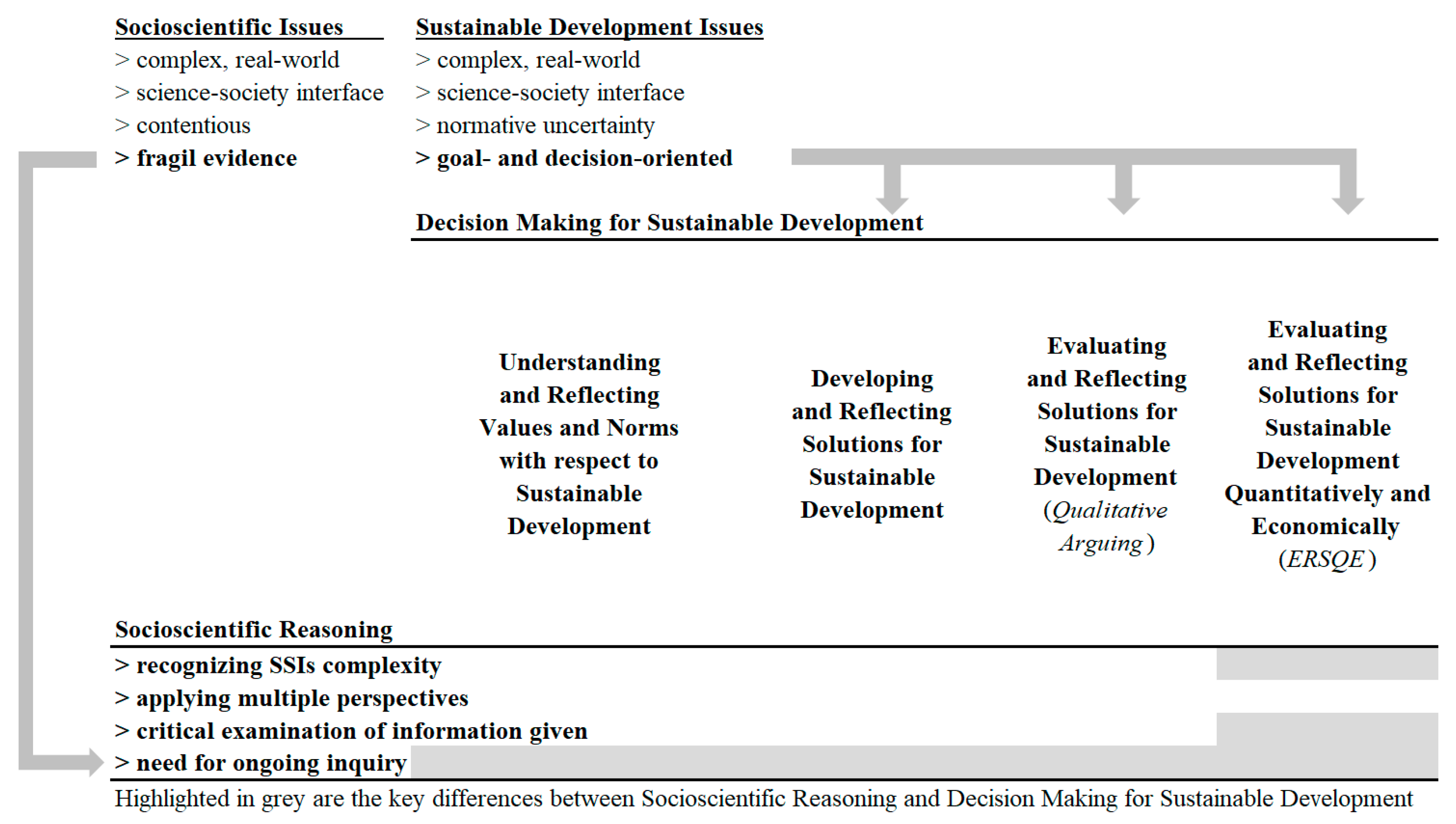
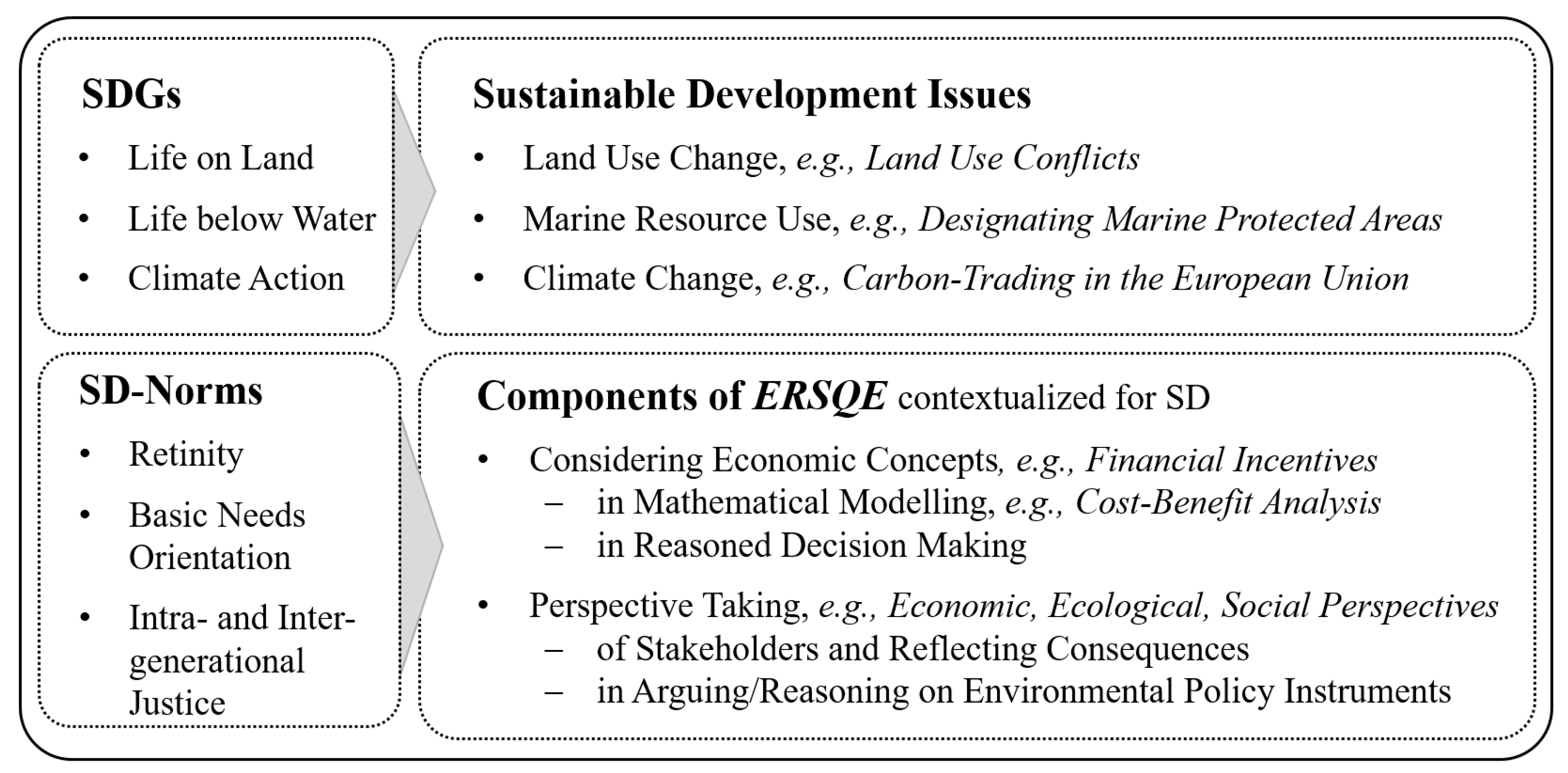
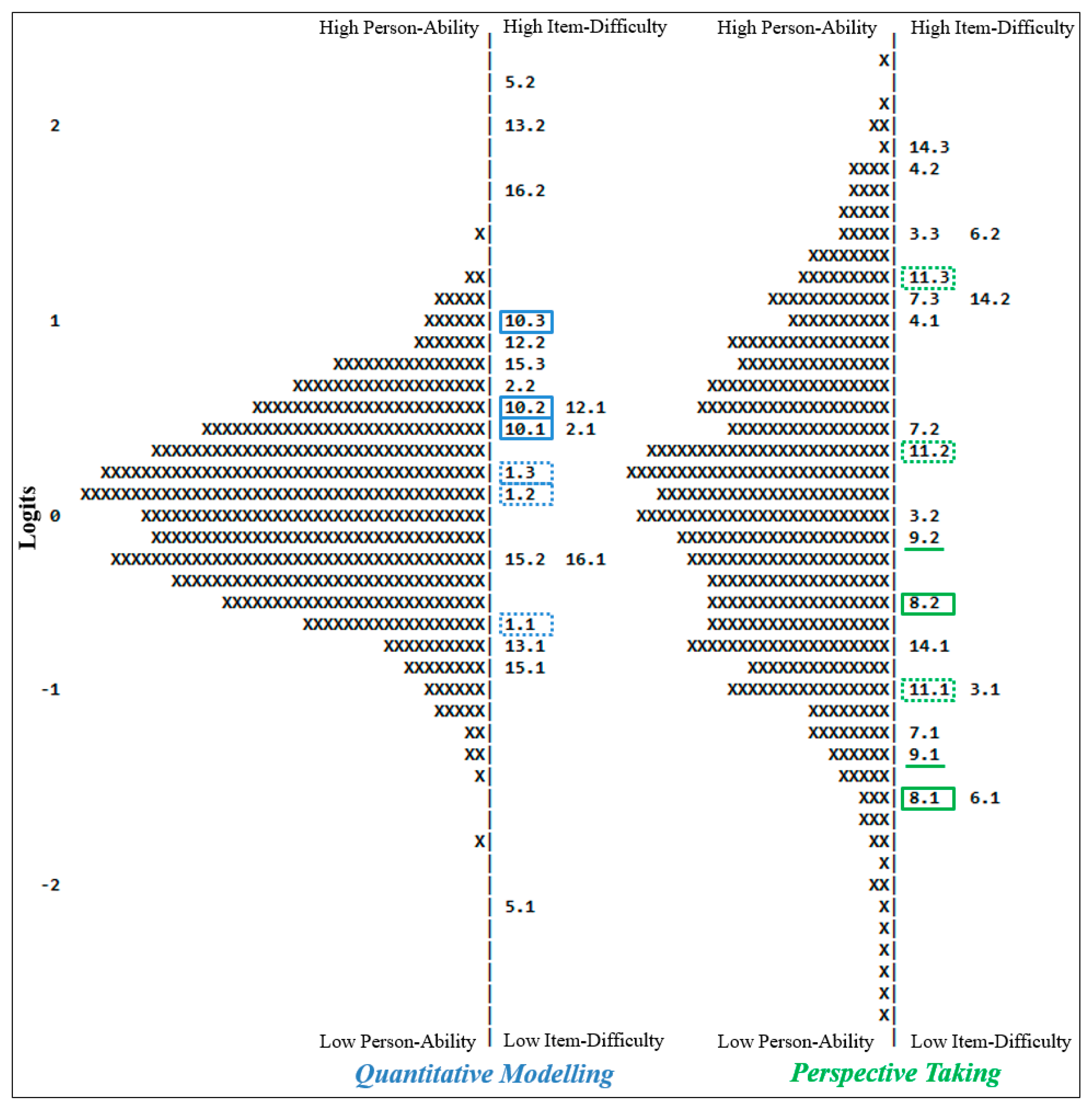
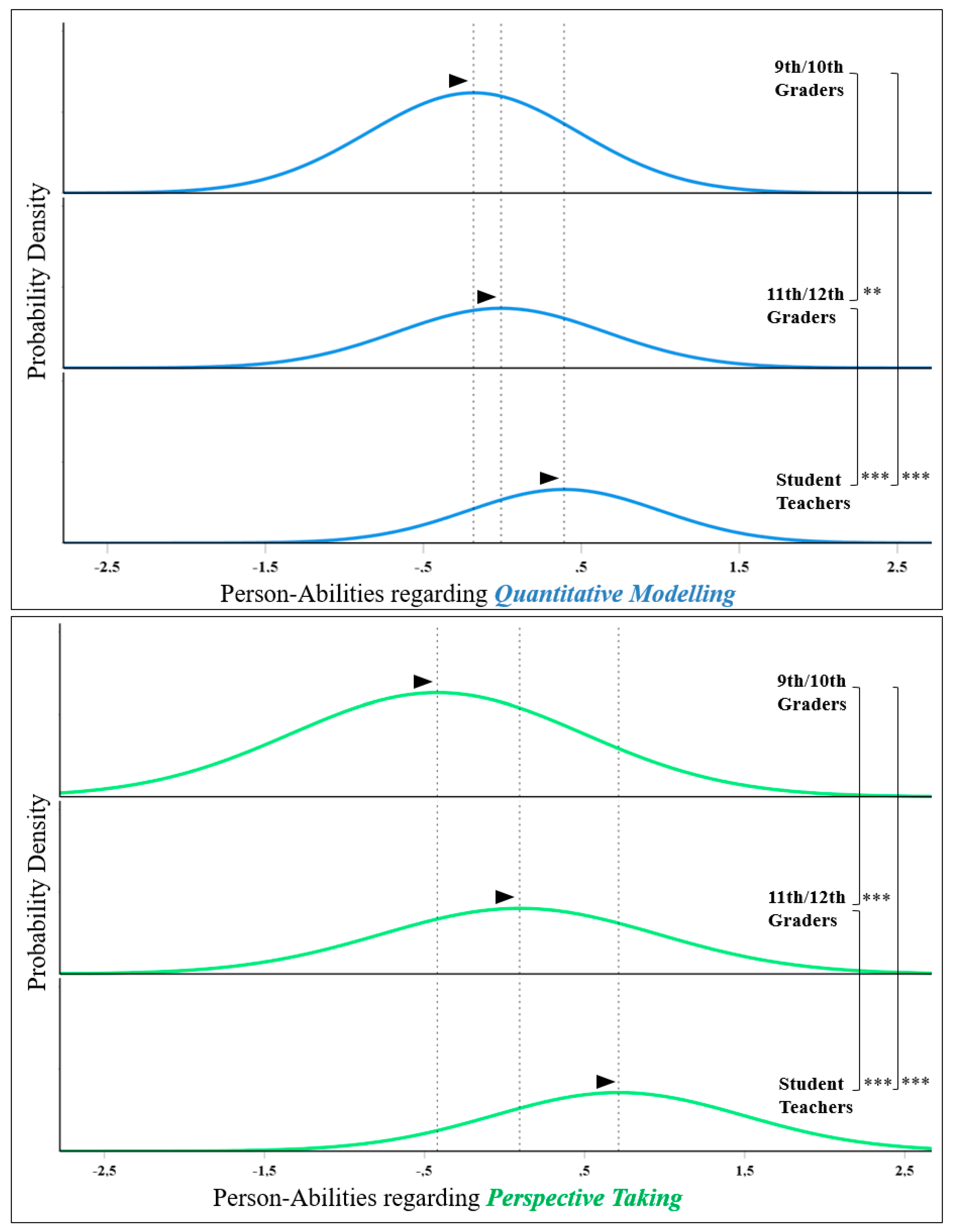

| Sample Composition | n | % (of Study) | Gender | n. sp. | Age [SD] | ||
|---|---|---|---|---|---|---|---|
| Female | Male | ||||||
| Competence Modelling | 9th/10th Graders | 368 | 48.4 | 171 | 186 | 11 | 15.23 [0.80] |
| 11th/12th Graders | 216 | 28.4 | 127 | 89 | - | 17.15 [0.76] | |
| Student Teachers | 176 | 23.2 | 117 | 58 | 1 | 22.49 [2.77] | |
| V-Study I | 9th/10th Graders | 109 | 57.1 | 49 | 59 | 1 | 15.01 [0.78] |
| 11th/12th Graders | 42 | 22.0 | 27 | 15 | - | 16.86 [0.65] | |
| Student Teachers | 40 | 20.9 | 29 | 11 | - | 22.95 [1.95] | |
| V-Study II | 9th/10th Graders | 71 | 100.0 | 46 | 24 | 1 | 15.03 [0.82] |
| Models | Parameters | Deviance | AIC | BIC | ΔDeviance (df) |
|---|---|---|---|---|---|
| 1D | 40 | 20515 | 20595 | 20781 | - |
| 2D | 42 | 20367 | 20451 | 20646 | 148 *** (2) |
| Quantitative Modelling | Perspective Taking | |
|---|---|---|
| Variance (SE) | 0.26 (0.03) | 0.71 (0.07) |
| EAP/PV Reliability | 0.53 | 0.70 |
| Item Reliability | 0.97 | 0.99 |
| Average Person-Ability (SE) | 0.00 (0.03) | 0.00 (0.04) |
| Average Item-Difficulty (SE) | 0.35 (0.13) | 0.08 (0.26) |
| Item-Difficulty from min. to max. value | −0.17 to 0.68 | −1.00 to 1.33 |
| Item Fit wMNSQ from min. to max. value | 0.96 to 1.06 | 0.93 to 1.17 |
| Discrimination from min. to max. value | 0.37 to 0.64 | 0.48 to 0.66 |
| Qualitative Arguing combined with | Models | Parameter | Deviance | AIC | BIC | Δ Deviance (df) |
|---|---|---|---|---|---|---|
| Quantitative | 1D | 40 | 6359 | 6439 | 6570 | - |
| Modelling | 2D | 42 | 6299 | 6383 | 6519 | 60 *** (2) |
| Perspective | 1D | 45 | 6983 | 7073 | 7219 | - |
| Taking | 2D | 47 | 6927 | 7021 | 7174 | 56 *** (2) |
| Quantitative Modelling | Qualitative Arguing | Economic Literacy | |
|---|---|---|---|
| Qualitative Arguing | 0.47 | ||
| Economic Literacy | 0.81 | 0.42 | |
| Mathematical Competencies | 0.60 | 0.41 | 0.52 |
| PerspectiveTaking | Qualitative Arguing | Economic Literacy | |
|---|---|---|---|
| Qualitative Arguing | 0.66 | ||
| Economic Literacy | 0.72 | 0.43 | |
| Mathematical Competencies | 0.32 | 0.41 | 0.51 |
| Quantitative Modelling | Perspective Taking | |||||||
|---|---|---|---|---|---|---|---|---|
| Educational Levels | 9th/10th | 11th/12th | 9th/10th | 11th/12th | ||||
| Subjects | r | N | r | n | r | n | r | n |
| Mathematics | 0.23 *** | 361 | 0.31 *** | 209 | 0.11 * | 361 | 0.19 ** | 212 |
| Politics/Economics | 0.34 *** | 348 | 0.25 ** | 173 | 0.28 *** | 347 | 0.28 *** | 176 |
| Biology | 0.24 *** | 356 | 0.34 *** | 197 | 0.29 *** | 354 | 0.25 *** | 200 |
| Geography | 0.25 *** | 347 | 0.23 ** | 146 | 0.25 *** | 347 | 0.24 ** | 147 |
| German | 0.20 *** | 361 | 0.14 * | 209 | 0.30 *** | 361 | 0.23 ** | 212 |
© 2020 by the authors. Licensee MDPI, Basel, Switzerland. This article is an open access article distributed under the terms and conditions of the Creative Commons Attribution (CC BY) license (http://creativecommons.org/licenses/by/4.0/).
Share and Cite
Böhm, M.; Barkmann, J.; Eggert, S.; Carstensen, C.H.; Bögeholz, S. Quantitative Modelling and Perspective Taking: Two Competencies of Decision Making for Sustainable Development. Sustainability 2020, 12, 6980. https://doi.org/10.3390/su12176980
Böhm M, Barkmann J, Eggert S, Carstensen CH, Bögeholz S. Quantitative Modelling and Perspective Taking: Two Competencies of Decision Making for Sustainable Development. Sustainability. 2020; 12(17):6980. https://doi.org/10.3390/su12176980
Chicago/Turabian StyleBöhm, Marko, Jan Barkmann, Sabina Eggert, Claus H. Carstensen, and Susanne Bögeholz. 2020. "Quantitative Modelling and Perspective Taking: Two Competencies of Decision Making for Sustainable Development" Sustainability 12, no. 17: 6980. https://doi.org/10.3390/su12176980
APA StyleBöhm, M., Barkmann, J., Eggert, S., Carstensen, C. H., & Bögeholz, S. (2020). Quantitative Modelling and Perspective Taking: Two Competencies of Decision Making for Sustainable Development. Sustainability, 12(17), 6980. https://doi.org/10.3390/su12176980





